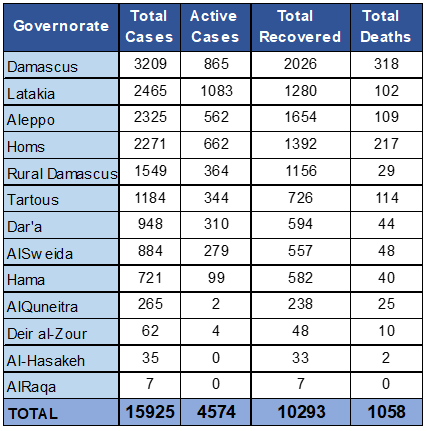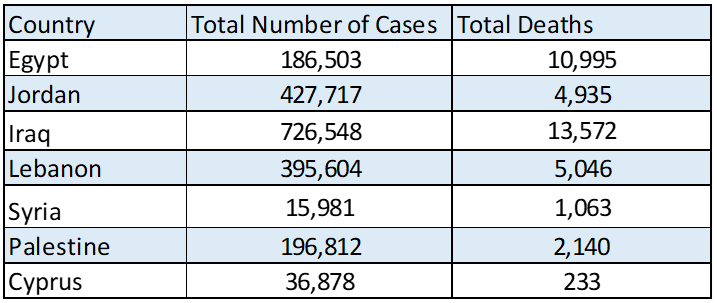MECC Coronavirus (COVID 19) Weekly Report
Syria: COVID-19
Humanitarian Update No. 50
Reporting period: from 2 to 7 March 2021
Coronavirus cases:15925 Active cases: 4574 Recovered: 10293 Deaths: 1058 [1]
Highlights
In GoS-controlled areas of the country,(as of 6 Feb), the Syrian Ministry of Health (MoH) reported 15925 Laboratory-confirmed cases, 1058 fatalities, and 10293 Recoveries.
15925 laboratory-confirmed cases have been reported by the Syrian MoH : 3209 in Damascus; 2465 in Lattakia; 2325 in Aleppo; 2271 in Homs; 1549 in Rural Damascus; 1184 in Tartous; 948 in Dar’a; 884 in Sweida; 721 in Hama; 265 in Quneitra; 62 in Deir-Ez-Zor; 35 in Al-Hasakeh and 7 in Ar-Raqqa.
The MoH has reported a further spike in healthcare workers affected, with 604 official cases, including 25 deaths.
As of 28 February, authorities in Northeast Syria (NES) have reported 8,608 cases, including 427 fatalities and 2,168 recoveries. Healthcare workers have also been affected, with 781 reported cases to date.
Since reopening in September, 2,221cases have also been reported in schools; including at least 21 reported deaths. Of these, 1,343were reported to be teachers/administrative staff.
The informal SYP/USD exchange rate has sharply declined to a new record low (approximately SYP 4,000 to US$ 1 on 7 March).
Preparedness and response
During the reporting period more than 2,063 suspected COVID-19 cases were investigated properly within 24 hours. In addition, WHO supported the transport of 450 specimens of suspected cases to the central laboratories.
WHO, in coordination with UNICEF, finalized key messages in Arabic and English concerning vaccines, which have been shared with the MoH for consideration. WHO also continued technical support for the MoH COVID-19 Dynamic Info graphic Dashboard for Syria, in Arabic and English.
UNFPA reported reaching over 17,000 people with COVID-19 related activities in the reporting period, including awareness raising through the integrated GBV/RH mobile teams, community wellbeing centers and women and girls’ safe spaces. This included a series of awareness raising sessions for 108 young people in Damascus.
In the reporting period, WHO supported 15 workshops on COVID-19 surveillance for 375 health workers in education settings, including on early detection and response. IMC further reported continuing active surveillance and suspected case finding utilizing a network of 32 physicians (pediatric, gynecology and general internal) in Damascus, Rural Damascus and Dar’a.
WHO supported two workshops for 50 participants to enhance preparedness and response capacity of PoEs, including specifically on IPC measures and risk communication.
In the reporting period, WHO supported further training in molecular biology, biosafety, and biosecurity procedures for 12 laboratory technicians in Hama and Lattakia.
WHO supported a meeting on the national testing strategy for COVID-19 and the plan for public laboratory expansion. WHO further supported the MoH in plans to conduct aserological epidemiological survey scheduled for March, including a workshop for protocol development and training for healthcare workers.
WHO dispatched over 55,000 PPE items to partners in Aleppo and in Qamishli, with the latter including for isolation centers.
UNDP has completed rehabilitation at a hospital isolation center in Damascus and during the reporting period, completed rehabilitation at additional healthcare facilities in Lattakia and Dar’a, with work in Deir-Ez-Z or ongoing and approximately 70 per cent completed to date. Rehabilitation at Dummar Hospital is ongoing. Other light rehabilitation, including WASH, by Première Urgence Internationale(PUI) and Medair, in Deir-Ez-Zor, Dar'a, Quneitra, Idleb and Aleppo has been completed, as per earlier reports.
WHO supported training for 100 health workers including on immediate life support and ventilator management in Damascus, Tartous, and Lattakia. Further,WHO provided 192,869 treatments of lifesaving medicines to partners in Aleppo, Al-Hasakeh, Deir-Ez-Zor,Damascus, Lattakia and Homs, including for COVID-19 cases.
WFP, as lead agency of the Logistics Cluster, is providing access to an air cargo transport service from Damascus to Qamishli. During the reporting period, the Logistics Cluster facilitated the transportation of 3MT of Health Sector cargo by air from Damascus to Qamishli. This is in addition to an UNHAS service for air passengers between Damascus and Qamishli. During the reporting period, the UNHAS service expanded to include twice-weekly flights to Aleppo
Vaccines
GAVI have indicated the first allocation of vaccines is anticipated by the end of the first quarter of 2021, or within the next quarter at latest, after its technical review and signing of the indemnity document with the manufacturer and confirming operational readiness.
Regular daily meetings of the three vaccine-related coordination committees have been held in past weeks (NCC National Coordination Committee, cTAG COVID-19 Technical Advisory Group and ICC Inter-Agency Coordination Committee), with WHO and UNICEF attending the latter, in addition to the 10 technical sub-committees. UNICEF has also commenced training of trainers on COVID-19 supply chain management for cold chain.
WHO is further providing ongoing support for the Vaccine Introduction Readiness Assessment Tool (VIRAT tool), which includes a set of 50 key operational activities
Work is ongoing to support other planning necessary for vaccine roll-out, including developing IPC and waste management protocols, national cold chain inventory, and planning to target hard-to-reach areas, including camps and settlements. Estimated operational costs for the first phase ofthe COVAX roll-out areUS$7 million($4.5 million for GoS-areas and NES, and $2.5 million for north-west Syria).[2]
[1] Microsoft power MOH,6 March 2021
[2] SYRIAN ARAB REPUBLIC: COVID-19Humanitarian Update No. 24 As of 3 March 2021
Lebanon: COVID-19
Humanitarian Update No. 47
Reporting period: from 2 to 8 March 2021
Coronavirus cases: 355,073 Deaths: 4,340 Recovered: 268,071
Highlights
WHO corona-related statistics
Despite the increase in corona cases, Lebanon is intent on easing the lockdown photo credit: arabianbusiness.com
During this reporting period, the average number of cases per day rose to 3,258.
Protests and demonstrations resumed in Lebanon, increasing infection rate.
The technical scientific committee set up by the Minister of Public Health, agreed to allow the issuance of an Emergency Use Authorization EUA for the Chinese vaccine SINOPHARM.
The Ministry of Public Health issued a report of the national vaccination campaign from 13 to 27 February 2021, which showed that 46,971 citizens had received the vaccine on date.
Coinciding with the phase of gradually easing the closure restrictions, the General Directorate of Internal Security Forces began, periodically and intensively, to its operational units to inspect the institutions that have reopened their doors, to ensure the extent of their commitment to the necessary and safe procedures.
The General Directorate of Public Security, based on the decision of the Presidency of the Council of Ministers related to updating the strategy to confront the "Corona" virus, announced the Lebanese and their family members stranded in Syria and wishing to return to Lebanon will be allowed to enter Lebanon through the Al-Masnaa and Aboudieh border centers on 10/03/2021.
The Ministry of Education and Higher Education issued Decision No. 67 / M / 2021 regarding the suspension of distance teaching work in all schools, high schools, and public and private institutes from the morning of Monday 8 March 2021 until the evening of Sunday 14 March 2021.
The National Operations Room for Disaster Management issued a statement requesting the security forces to take the necessary measures to control the violations of the ski centers in the regions of faraya and Kafr Dibian.
Communication and Public Relations Department




